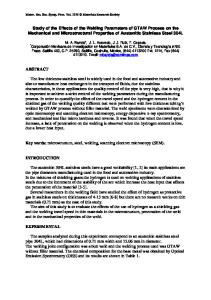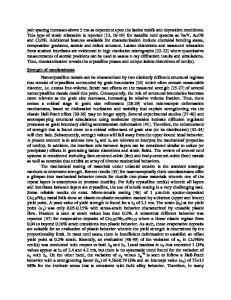On the Effects of the Rejuvenation Treatment on Mechanical and Microstructural Properties of IN-738 Superalloy
- PDF / 5,332,439 Bytes
- 13 Pages / 593.972 x 792 pts Page_size
- 99 Downloads / 352 Views
JMEPEG (2017) 26:2244–2256 DOI: 10.1007/s11665-017-2646-2
On the Effects of the Rejuvenation Treatment on Mechanical and Microstructural Properties of IN-738 Superalloy Cosimo Monti, Alessandro Giorgetti, Leonardo Tognarelli, and Francesco Mastromatteo (Submitted June 7, 2016; in revised form December 16, 2016; published online April 3, 2017) The main scope of this paper is to show the effects of a specific rejuvenation treatment studied for IN-38 on both the microstructure and the mechanical properties of the creep-damaged superalloy and to compare the tests results with the virgin material and with the recovery obtained through the standard heat treatment. This work will show that this rejuvenation treatment is able to recover the microstructure of creepdamaged specimens and that the creep and tensile properties of the rejuvenated alloy are even better than the virgin material for the tests performed. Moreover, it will be shown that the standard heat treatment provided for IN-738 is not able to fully recover the microstructure and that the creep properties of the superalloy during the tests have been lower than the virgin material. Keywords
heat treatment, IN-738, mechanical and creep, microstructure
1. Introduction IN-738 is an equiaxed nickel-based superalloy. It is a vacuum-melted, vacuum-cast precipitation hardenable superalloy with excellent high-temperature creep-rupture strength combined with hot corrosion resistance superior to that of many high-strength superalloys of lower Cr content. For these reasons, IN-738 is mostly used in the gas turbine industry for engine parts that work at high temperatures and stresses combined with corrosion (Ref 1). Most of the applications for this alloy concern blades, vanes, and integral wheels (Ref 1, 2). Table 1 shows the nominal composition range of IN-738LC, the low carbon version of the superalloy, used for this study (Ref 3). The high strength of IN-738 derives from the following mechanisms: solid solution strengthening by Cr, Mo, W, and Co, precipitation hardening by c¢ phase consisting of Ni3(Al, Ti), and grain boundary strengthening by carbides. The microstructure of the new material after the standard heat treatment, condition considered as virgin alloy in this study, is in fact characterized by a bimodal distribution of c¢ precipitates, with cuboidal larger particles of primary c¢ and smaller spherical particles of secondary c¢, by coarse primary MC carbides at both the grain core and the grain boundaries and secondary M23C6 carbides at the grain boundaries. Most of carbides in the as-cast structure are of MC type with a variable Cosimo Monti and Alessandro Giorgetti, Department of Innovation and Information Engineering, Guglielmo Marconi University, Plinio Street, 44, 00193 Rome, Italy; and Leonardo Tognarelli and Francesco Mastromatteo, Nuovo Pignone Tecnologie SRL, GE Oil & Gas, F. Matteucci Street, 2, 50127 Florence, Italy. Contact e-mails: [email protected], [email protected], [email protected], and [email protected].
22
Data Loading...











